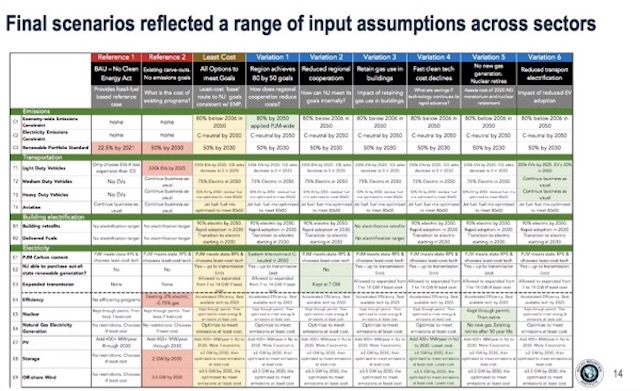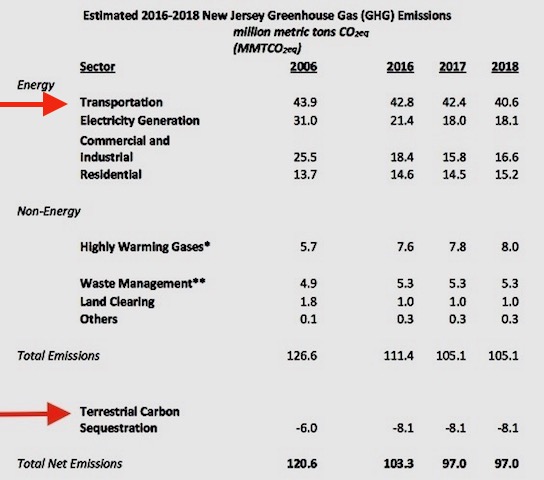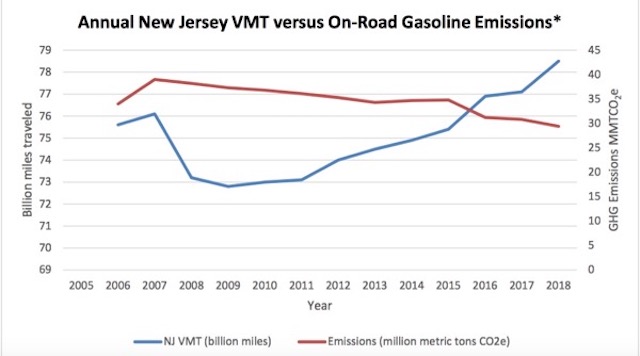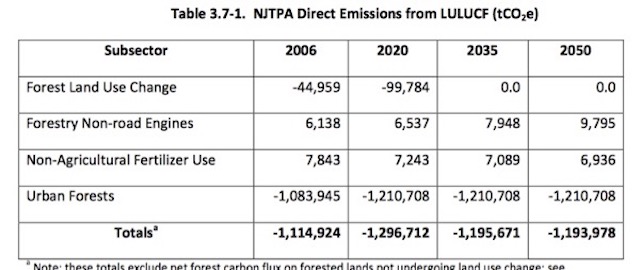Murphy DEP Already Running Away From Climate Regulations
Contrary To Science, Gov. Murphy Sees No Climate Emergency
Huge Gap Between Press Release Rhetoric and Regulatory Reality Grows
NJ Spotlight coverage regurgitates fact free corporate talking points
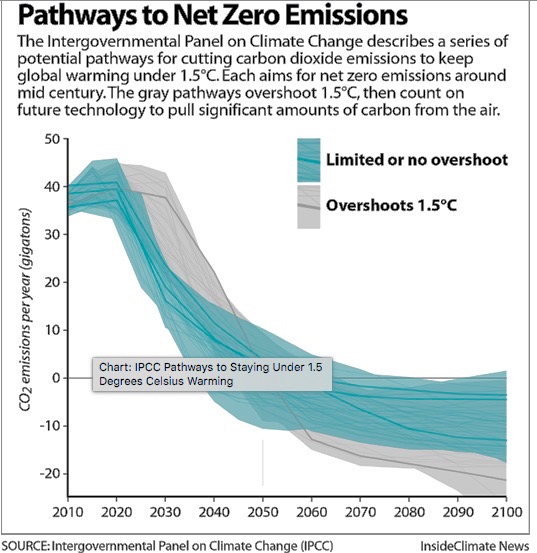
You will not see a graph like this in the Murphy BPU Energy Master Plan or DEP Greenhouse Gas Inventory Reports
This is Part One of a series.
The ink was barely dry on Gov. Murphy’s Executive Order on climate before his DEP began running away from it.
Because I’ve been advocating for and writing about the failure of DEP to regulate greenhouse gas emissions and adopt rules necessary to adapt to climate change for over a decade, of course I’d been planning to write about NJ Gov. Murphy’s Executive Order #100, which directs DEP to regulate greenhouse gas emissions and incorporate climate adaptation in regulatory programs, and DEP Commissioner McCabe’s Administrative Order No. 2020-01.
Keep in mind that, way back on October 7, 2007, in a Sunday Star Ledger Op-Ed (see: “No Teeth in “Tough” Pollution Law” – sorry no link), while everybody – and I mean everybody – was cheerleading, we alone correctly called bullshit on the highly touted Global Warming Response Act. Our criticisms have been vindicated by history.
In fact, my previous post on Feb. 5 that was critical of Gov. Murphy’s Energy Master Plan’s approach to reducing greenhouse gas emissions from buildings – closed with this commitment:
We’ll be doing additional posts on the EMP as well as the Governor’s Executive Order and the DEP Commissioner’s Administrative Order.
This will take several posts – the Gov. has crafted a bizarrely complex byzantine bureaucratic exercise that requires cross-walks between four EO’s, DEP’s AO, IEP, EMP, DEP, BPU, DCA RGGI, & 3 recent energy laws – but let’s start today with the media coverage.
Just 2 days after I promised to write about DEP regulation, NJ Spotlight – the media outlet where “issues [used to] matter” more than Foundation funding and corporate advertising – weighed in with this openly hostile and incredibly biased spin (it actually gets worse after the headline):
As I’ve noted, this is another troubling story in what is now an obvious pattern in false framing, biased content, and reliance on highly questionable sources. A pattern I’ve called “journalistic malpractice” (note that “green” sources in NJ Spotlight stories are almost always the same groups funded by the same elite Foundations that also fund NJ Spotlight, i.e. Wm. Penn & Dodge Foundations and The Fund for NJ. That pattern is strong evidence of how elite Foundations abuse the public interest in how they:
1. define or hijack the policy agenda;
2. fund and co-opt “safe” “moderate” environmental groups to conduct “campaigns” on that agenda. Those campaigns are designed not to threaten existing corporate or political power;
3. Foundations then fund the media outlets to publicize that agenda; and
4. the media outlets then source stories on agenda issues with quotes from the Foundation funded groups or name them as Roundtable panelist and faux “experts”.
It’s one big self serving scam, reflecting Neoliberal ideology – a dynamic that others have called an “Elite Charade”. I call this “news management“. Ironically, when the right wing adopts similar tactics, it’s correctly denounced as disinformation, propaganda, an “echo chamber”, or “vast conspiracy”.)
While NJ Spotlight has published scores of stories, Op-Ed’s, “sponsored content” and held several issue “Roundtables” that focus almost exclusively on the alleged “high cost” of climate programs – from energy efficiency to renewable energy – stories that quote various corporate hacks, I can count on one hand the number of stories NJ Spotlight has published about the most recent IPCC “Special Report” and dire warnings from scientists that we have about a decade to act to deeply reduce GHG emissions to avoid irreversible and potentially catastrophic impacts:
The [IPCC] report finds that limiting global warming to 1.5°C would require “rapid and far-reaching” transitions in land, energy, industry, buildings, transport, and cities. Global net human-caused emissions of carbon dioxide (CO2) would need to fall by about 45 percent from 2010 levels by 2030, reaching ‘net zero’ around 2050.
Ironically, while Gov. Murphy’s own Executive Order repeatedly cites the IPCC’s science, amazingly, it somehow ignores the policy implications of the IPCC warnings, i.e. a “rapid” 45% emissions reduction by 2030.
As we’ve written, Gov. Murphy’s Energy Master Plan assumes that GHG emissions will continue to grow and that significant emissions reductions will not BEGIN until after 2030. Just LOOK:
Now, after the huge embarrassment of a 2 year energy planning process at BPU being made obsolete by the climate science, the Gov. has issued an Executive Order mandating climate regulations by DEP (read the Murphy press release).
Given that embarrassing BPU experience – and the dire warnings of science – one would think that the Gov. would have learned the lesson of delay.
One would be wrong: The Gov. Executive Order shows no sign of urgency and gives DEP two more years to adopt regulations (which would then take several more years to implement and enforce).
In contrast to that two year delay, Gov. Murphy could have declared a climate emergency in his Executive Order, invoking the Governor’s constitutional emergency powers. An emergency declaration would have had multiple benefits:
1) it would have reflected the science and aggressive timetables to produce real & deep greenhouse gas emissions reductions;
2) it would have enabled issuance of a moratorium on DEP and BPU approvals of “more than a dozen” pending fossil infrastructure projects;
3) it would have authorized DEP to adopt regulations (effective on publication in the NJ Register) without going through the lengthy procedural requirements of Gov. Murphy’s own Executive Order and the NJ Administrative Procedures Act (see NJAC 1:30-6.5 Emergency rule adoption and concurrent proposal). Emergency rulemaking that provides streamlined regularly adoption prior to notice and comment also maximizes the role of science and the control of DEP experts, while minimizing political intervention in rule development by corporate economic interests;
4) it would have bolstered the validity and legal defensibility of any DEP regulations which are almost certain to prompt litigation; and
5) it would have sent a strong message about priorities and educated the public about the climate emergency.
But instead of a moratorium on new fossil infrastructure enforced via DEP regulations, the Gov. has opted for putting BPU in charge of more delay.
And get this: with respect to infrastructure, the BPU will not be evaluating a moratorium on infrastructure and the attainment of any 45% reduction in existing emissions by 2030. Instead, BPU will consider “the need for future expansion”!. Here’s the relevant text of the Murphy EMP:(@ page 189)
Goal 5.4.1: Develop a planning process to quantify and analytically assess the need for future expansion of the gas system and take appropriate action.
The last decade has seen unprecedented growth of the natural gas system, due largely to the discovery of domestic shale gas and subsequent low fuel prices. New Jersey currently has more than a dozen natural gas infrastructure projects under consideration at NJDEP and NJBPU, including pipelines, power plants, and a compressor station.
New Jersey would benefit from a comprehensive assessment of the gas system and its future needs. Consistent with recent deliberations, NJBPU will commission a study to assess if and where the system is approaching capacity limits, and where the system is being underutilized. Following this analysis and recognizing the importance of stakeholder involvement as an integral part of the process, including consumers, utilities, advocacy organizations, and others, NJBPU will undertake a stakeholder proceeding. The purpose of this proceeding is to take feedback from all interested parties as part of the Board’s evaluation of the analysis. Evaluation and consideration of the analysis along with the stakeholder feedback will inform future Board action on utility filings.
More process. More delay. While GHG emissions continue to increase. Pending “dozen” fossil infrastructure projects may receive regulatory approvals during at least 2 year period of delay due to BPU planning and DEP regulatory development. Ta da!
In addition to failing to declare an emergency and establish a moratorium on regulatory approvals of new fossil infrastructure, the Gov.’s Executive Order failed to direct his Department of Community Affairs to update building codes to reduce GHG emissions.
But, before I delve further into the weeds and wonking on the substance of the Gov.’s EO and DEP’s AO – which I will do in subsequent posts – let’s get back to the media coverage, and responses by DEP and environmental cheerleaders.
As previously noted, NJ Spotlight chose to ignore science and law and write its first story about DEP regulations from the business community’s perspective (as if the NJ Chamber of Commerce and the NJ Business and Industry Association lacked an effective voice in Trenton).
Of course, the business community savaged the idea of DEP regulation and invoked the same old tired spin and lies about alleged devastating impacts on jobs and economic growth.
One would think that professional journalists would be skeptical of all that jive. Again, one would be wrong.
So, how did the Murphy DEP respond? Diid they push back? Did they invoke science?
Nope.
They put their tail between their legs and ran, by recycling almost verbatim the slogans and mantras that date to the 1990’s Whitman “Open For Business” DEP: (Does anyone still recall Whitman’s “Green and Gold” slogan?)
“We’re at the beginning of the next chapter, and we’re inviting the business community to come with us in writing the next chapter,” LaTourette said in an interview with NJ Spotlight. “We’re going to be with them shoulder to shoulder, just like we are with local governments and our partners in the advocacy community because we are really all in this together.” …
The regulations that will come out of the new process will be as much about economic vitality as about environmental protection, LaTourette said. “We don’t believe in that false dichotomy that you can have a clean environment or economic development — those two things go hand in hand.”
Jane Cohen, a senior adviser to Murphy on environmental affairs, also said the EMP process included economic development.
“The Governor has been very clear that part of what he is looking at when formulating his policies around addressing climate change are exactly around economic development,” she said. “He really wants to support economic development through clean-energy policies.”
Translation:
1. Economic growth and corporate profits are equal to or a greater priority than climate science and avoiding climate catastrophe.
2. The business community literally will be involved in drafting the regulations, i.e. “in writing the next chapter”.
This is the case because Gov. Murphy’s Executive Order on regulatory policy reinforced the Christie Executive Order #2 rulemaking process provisions, in terms of involving the business stakeholders early on in rule drafting prior to rule proposal.
3. The DEP point person on this critical regulatory initiative, DEP Chief of Staff Shawn Latourette, is a former corporate lawyer.
Scroll down and review his professional experience and publications.
I was particularly impressed with this piece, which he wrote while still in Rutgers Law School – while located in a major petro-chemical state, at a time when DEP had just launched a new major Natural Resource Damage (NRD) enforcement program on toxic polluters. The piece amounts to a transparent flashing Bright Red Neon Sign solicitation that literally says to corporate polluters: “Hire me, I’ll help you get off the hook from punitive pollution damages and enforcement penalties”
The colloquial phrase the “red light district” as a zone of prostitution has a factual basis – the whores would light red lamps in their windows to signal availability.
Mr. Latourette, via that “Exxon Valdez” publication, lit a bright red light in his legal window.
4. Former Wall Street Goldman Sachs man Gov. Murphy is sending a message to the business community: don’t worry, I’ve got DEP on a short leash and my office is directly involved, so any DEP rules will be more of the same: big on rhetoric, small on substance.
5. DEP views climate polluters as “partners” – not the arms length regulated community – with the same legitimacy, access, and influence as their environmental friends. This effectively maintains continuity with the “customer friendly” policies of the Christie DEP.
Finally, we close today’s post by a brief look at the “response” of the environmental community.
We note that predictably, sycophant and Green Cannibal Ed Potasnak (NJ LCV), who politically endorsed and funded Gov. Murphy’s campaign and has lied and spun to provide political cover for the Gov., was quoted in Gov. Murphy’s press release.
So were incompetent boot lickers Tom Gilbert (Rethink NJ/NJCF) and Amy Goldsmith (who endorsed Chris Christie in 2009).
Amy Goldsmith was a member of the Empower NJ Coalition. That Coalition was demanding and waged a two year campaign seeking a moratorium on new fossil infrastructure. How the hell could she sell them out by publicly supporting and praising Gov. Murphy’s plans – in the Gov.’s press release – a policy and plan that destroys the concept of a moratorium?
The only surprise was Doug O’Malley of Environment NJ, whose recent actions on EV legislation, RGGI, the Delaware River, and lead in drinking water, among others, demonstrate that he’s joined the Green Cannibals and gone all in for the Foundation funding and NJ Spotlight panels that political sycophancy delivers.
Of course NJ Spotlight – funded by the same elite Foundations that fund the Green Cannibals and sycophants – quoted these fools in their coverage and ignored critics.
Over the last several weeks, aware that the Gov. would soon be releasing the Energy Master Plan and likely announcing a DEP climate strategy, I posted several times to set the expectations, policy framework, and to warn people of the abuses that were likely to occur.
I focused on 3 important things:
1) the media coverage:
2) the complete corruption and co-optation of the environmental community:
3) there is a huge gap between the Gov.’ climate rhetoric and the policy and regulatory content:
- Murphy DEP Rules Exclude Climate Change In Infrastructure Planning
- Highly Touted “Transformative” Electric Vehicle Program Has Negligible – If ANY – Impact On Greenhouse Gas Emissions
- NY Times Coverage of Building Electrification Should Spur Scrutiny Of NJ Gov. Murphy’s Energy Master Plan
We warned you. And we predicted the current outcome.
So, once again, just like we called bullshit on the Global Warming Response Act over 12 years ago, we must call BS on Gov. Murphy.
Stay tuned for next installments, where we analyze the content of the Gov.’s Executive Order and the DEP Administrative Order.
